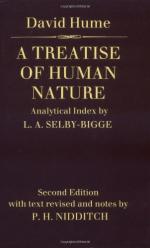These examples from history and common experience are rich and curious; but we may find parallel ones in the arts, which are no less remarkable. should an author compose a treatise, of which one part was serious and profound, another light and humorous, every one would condemn so strange a mixture, and would accuse him of the neglect of all rules of art and criticism. These rules of art are founded on the qualities of human nature; and the quality of human nature, which requires a consistency in every performance. is that which renders the mind incapable of passing in a moment from one passion and disposition to a quite different one. Yet this makes us not blame Mr Prior for joining his Alma and his Solomon in the same volume; though that admirable poet has succeeded perfectly well in the gaiety of the one, as well as in the melancholy of the other. Even supposing the reader should peruse these two compositions without any interval, he would feel little or no difficulty in the change of passions: Why, but because he considers these performances as entirely different, and by this break in the ideas, breaks the progress of the affections, and hinders the one from influencing or contradicting the other?
An heroic and burlesque design, united in one picture, would be monstrous; though we place two pictures of so opposite a character in the same chamber, and even close by each other, without any scruple or difficulty.
In a word, no ideas can affect each other, either by comparison, or by the passions they separately produce, unless they be united together by some relation, which may cause an easy transition of the ideas, and consequently of the emotions or impressions, attending the ideas; and may preserve the one impression in the passage of the imagination to the object of the other. This principle is very remarkable, because it is analogous to what we have observed both concerning the understanding and the passions. Suppose two objects to be presented to me, which are not connected by any kind of relation. Suppose that each of these objects separately produces a passion; and that these two passions are in themselves contrary: We find from experience, that the want of relation in the objects or ideas hinders the natural contrariety of the passions, and that the break in the transition of the thought removes the affections from each other, and prevents their opposition. It is the same case with comparison; and from both these phaenomena we may safely conclude, that the relation of ideas must forward the transition of impressions; since its absence alone is able to prevent it, and to separate what naturally should have operated upon each other. When the absence of an object or quality re moves any usual or natural effect, we may certalnly conclude that its presence contributes to the production of the effect.
SECT. IX OF THE MIXTURE OF BENEVOLENCE AND ANGER WITH COMPASSION AND MALICE




